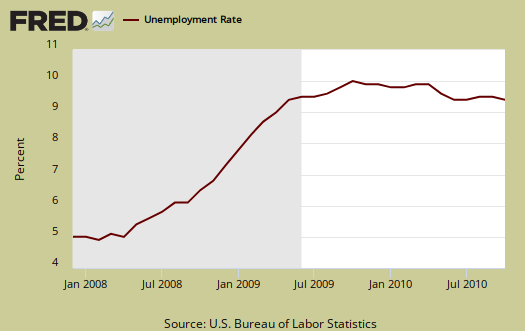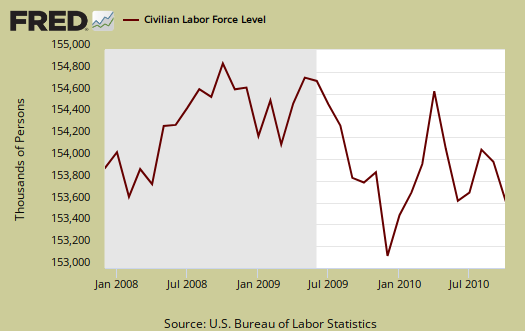The October 2010 monthly unemployment figures are out. The official unemployment rate stayed the same at 9.6% and the total jobs gained were 151,000, with 34,900 of those jobs being temporary. Total private jobs gained was 159,000, in stark contrast to the 43,000 ADP reported. Those added to not in the labor force was +462,000. That's almost half a million people in one month falling off of the count. The labor force participation rate dropped -0.2% to 64.5%. This is the lowest labor participation rate since 1984. U6, or the broader unemployment measurement, is now 17.0%.

Below is the nonfarm payroll, seasonally adjusted. Since this recession the United States has officially lost 7.5 million jobs and that includes the 874,000 jobs added in the past year.

Below is a running tally of how many official jobs permanently lost since the official start of this past recession (recall the private NBER has declared the recession over!). This is a horrific tally and notice this isn't taking into account increased population growth.

Those not in the labor force increased by +462,000. The civilian labor force decreased by -254,000. Of those still in the civilian labor force, employed, decreased by -330,000 in October, yet those unemployed increased by 76,000. What we see here are people simply dropping out of the count. Yet because there were no jobs, we can see more people fell off of the count.
The civilian population rose by 208,000 last month. The civilian population now stands at 238,530,000. Yet those not in the labor force are now an astounding 84,626,000.
-293,000 people lost their job last month, officially fired. Then only 47,000 people quit. This means very few people will dare quit a job these days. Of those unemployed the number of re-entrants, or people trying again, increased by +76,000. New entrants into the job market who don't have a job increased by 86,000. Notice that the totals of fires and quits exceeds those job losses reported by 10,000, so 10,000 must be temporary jobs as the fires.


The long term unemployed (> 27 weeks) increased by +83,000. 58.8% of the official unemployed have been so for 15 weeks or longer. But because we see no real job growth, this implies people are dropping from the count.
- Long term unemployed - 6.123 million
- Forced Part Time - 9,154 million
- Marginally attached to the labor force - 2,602 million
Of the Marginally attached, 1,219 million are discouraged. While forced part-time dropped 318,000 this month (which should be good because these are people whose hours were cut), the marginally attached, or those not counted but really wanting a job, increased 200,000 over the past year.

U6, defined as total unemployed, plus all persons marginally attached to the labor force, plus total employed part time for economic reasons, as a percent of the civilian labor force plus all persons marginally attached to the labor force, (table A.15), was 17.0%, a -0.1% decrease from last month. This number is obscene. Then 41.8% of the official unemployed have been so for 27 weeks or longer and those unemployed for 27 weeks or longer increased 83,000.
One needs at least 125,000 and some estimate up to 300,000 permanent full time jobs, added each month just to keep pace with U.S. civilian workforce population growth. That's not general population, that's the group needing a job. To even get back to pre-recession unemployment rate levels we need a good 424,000 jobs created each month. That's permanent jobs.
The civilian labor force participation rate is now 64.5%. The employment to population ratio decreased -0.2% to 58.3% also at record levels. This isn't a structural change, such as all families decided to have a stay at home caretaker, or magically a host of people could retire early, this is people dropping out of the count.
These numbers are important because unemployment is a ratio, percentage or during a limited time period, the number of people actively looking for a job and counted. Many people are not counted in the official unemployment statistics, due to definitions, but obviously when one has more potential workers and less jobs, that metric doesn't bode well for America.

Below is the graph of the civilian non-institutional population, which is the largest super-set of the potential labor force, larger than the civilian workforce, due to those who are not looking for work, retired and so on being counted in this figure. It increased this month by 208,000. Except for some statistical adjustments, the monthly rate of change in civilian non-institutional population is a reasonably constant 1% population growth. This is why one must create jobs greater than the constant rate of jobs lost. There are more people to employ.
Unemployment is a percentage, a ratio.
The BLS unemployment report counts foreign temporary guest workers as well as illegal immigrants in their U.S. labor force statistics.

In looking over table B1 we can get a little more detail on what kind of jobs were created (and lost) on the permanent jobs front. These sectors include temporary jobs. OF Professional & Business Services, temporary jobs were 34,900. Without temp jobs, the sector lost jobs. -5,000 of the government jobs lost were temporary Census jobs and the Census skewing the unemployment numbers is basically over.
- Financial: -1,000
- Information: -1,000
- Construction: +5,000
- Manufacturing: -7,000
- Mining & Logging: +7,000
- Health and Education: +53,000
- Leisure and Hospitality: -5,000
- Professional & Business Services: +46,000
- Temporary: +34,900
- Trade, Transportation, Utilities: +37,000
- Government: -8,000
3,000 of the manufacturing job losses were in durable goods. Local government lost 7,000 jobs with 7,800 job gains in education for local government jobs included.
Bear in mind illegal workers and foreign guest workers are counted as employed Americans, which can distort occupational sectors, particularly the Science and Technology ones. Below are the unemployment rates per occupational sector from table A-14, not seasonally adjusted. Look at how high information, professional and business services is. Tell me offshore outsourcing is not having an effect again. The BLS claims jobs have been created in these areas, this month 8,000, yet look at the unemployment rate in this area. Something is wrong with this picture. Could it be foreign guest workers included in the job count?
- Financial: 6.7%
- Information: 9.8%
- Construction: 17.3%
- Manufacturing: 9.5%
- Mining & Gas, Oil: 10.4%
- Health and Education: 5.8%
- Leisure and Hospitality: 11.1%
- Professional & Business Services: 10.6%
- Retail, Wholesale Trade: 9.2%
- Government: 4.3%
- Agricultural: 11.0%
- Self-employed, unpaid family: 5.4%
You probably also want to know the birth/death model. What is that? It's a statistical adjustment to compensate for new businesses and dead businesses who are not actually tallied by data reports. Those jobs created and died outside the statistical reporting time window due to lag. So, the BLS estimates how many jobs can be attributed to those firms which are not actually counted. This month's adjustment was 61,000 jobs. Now one cannot directly subtract the birth/deal model monthly numbers, because unemployment data is seasonally adjusted, yet the birth/death adjustment is not seasonally adjusted, get that? Anywho, jobs attributed to new and dead businesses are just an estimate in so many words.
The average work week barely increased to 34.3 hrs/wk, by 17 minutes. Average earnings (drum roll please), increased 5¢ to $22.73/hr. That's the biggest jump, if one wants to call 5&ent;a jump, in months. Some good news manufacturing jobs are at 40.3 hrs/wk, so manufacturing has recovered to full time work . Take a look at how many industry sections are below full time hours. When the number of hours per worker is below full time, beyond the labor implications, there also is a common practice among employers to keep workers part-time, in order to deny them benefits.

Here is last month's report. The below revisions are astounding, with an error of over 50% on the jobs lost or gained.
The change in total nonfarm payroll employment for August was revised from -57,000 to -1,000, and the change for September was revised from -95,000 to -41,000.
Subject Meta:
Forum Categories:
| Attachment | Size |
|---|---|
| 236.83 KB |

Recent comments